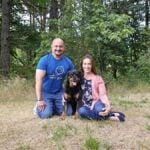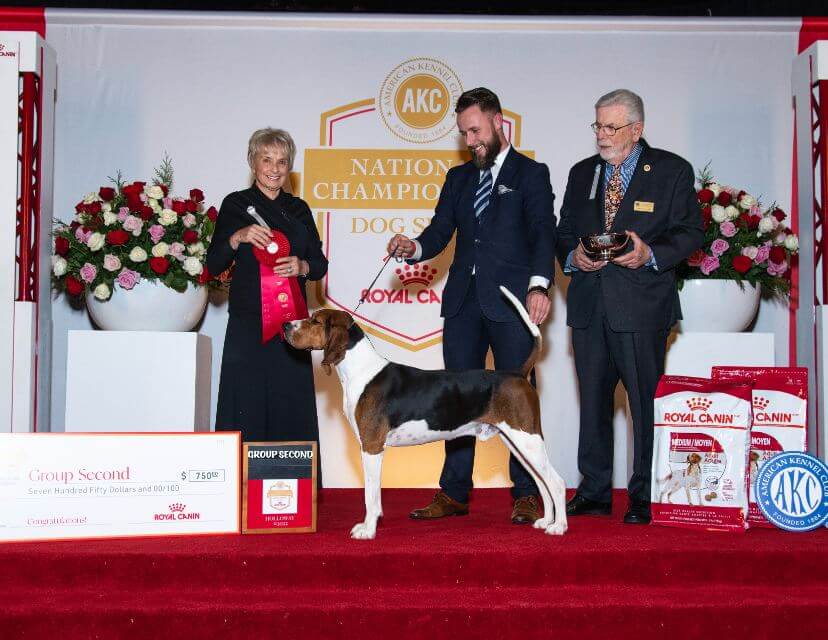


Home » Cole Vanover | Lost Heritage Hounds

Cole Vanover: I grew up in Valley Station, Kentucky, which is a southern suburb of Louisville, about 20 minutes from the dog show site.
Cole Vanover: My family has always had coonhounds. My grandfather, Johnny Vanover, Jr., aka “Pappy” as he was known by us grandchildren, started coonhunting with his Uncle Russell when he was a kid. He grew up in the Appalachian town of Pikeville, Kentucky. He would also drag the scent bags for the coonhound field trials. Shortly after marrying my grandmother, Patty, they moved to Louisville where Pappy continued to breed and train coonhounds. Mostly Treeing Walkers, although he dabbled in other coonhound breeds from time to time such as Black and Tans, American English, and Redbones. I started coonhunting with him when I was eight years old. I had always enjoyed helping him care for the dogs at home, but listening to them trail and tree started a completely different level of passion inside me. My grandfather left us a few dogs when he passed away, so I got my dad to start coonhunting again. We started in the competition hunts with “Abe.” He soon finished as a Grand Nite Champion. I started showing in Coonhound Bench Shows shortly after that, before Treeing Walkers were recognized by AKC.

Cole Vanover: I have had many mentors in the sport, whether they are aware that they were or not. Notably, the biggest influence on me regarding breeding dogs for conformation has been Scott Houston of Cherry Creek Kennel. My first show dog, Cherry Creek Faith, was out of his World Show Champion Cherry Creek Banjo Rick. We met through that connection. “Faith” and I also went on to win a World Championship title, which is probably a lot of the reason I’m still showing dogs today. Starting out with a dog of that caliber really teaches you a lot and lights a fire deep inside you. Scott taught me a lot regarding mixing pedigrees, looking at the littermates of the breeding prospects you have to determine what other traits you might end up with, and understanding that the dog or bitch you’re breeding is only as good as the weakest link in their pedigree. I learned the latter the hard way. I bred to an outstanding dog quite a few years back, but his dam was subpar. He was an “anomaly of his pedigree,” if you will. Long story short, we got a couple of decent puppies but nothing to get overly excited about.
Cole Vanover: We have had success breeding across multiple breeds. Most notably, GCHG Lost Heritage Knight Of Eldorado, “Nate.” Nate has won the first two NTWCA National Specialties, 13 all-breed Bests in Show, 100-plus Hound Groups, a two-time Top 5 Hound, and is the top-winning Treeing Walker Coonhound in breed history. We also co-bred the current No. 1 American Foxhound, GCHB Lost Heritage Time Bandit At Kiarry, “George,” with our client, Stephen Grossman. George is just shy of two years old and already has four Bests in Show under his belt.
We based our Treeing Walker breeding program on two bitches, CH Lost Heritage Cherry Crk Nothin’ Fancy, “Fancy,” and GCHB Lost Heritage Cherry Crk Gone With The Wind, “Scarlett.” They were both nice bitches, but for completely different reasons. Their pedigrees were very similar about four or five generations back, but the dogs in the first few generations of their pedigrees went in completely different directions. On one hand, you had a pedigree full of dogs whose breeders focused on movement, and on the other hand, you had breeders who focused on style. Scarlett ended up producing NBISS MBIS GCHG Lost Heritage Knight Of Eldorado, “Nate.” Scarlett moved like a dream but lacked some breed type and style
. So, we bred her to an extremely typey dog that was a little overdone. Fancy, on the other hand, had a pedigree loaded with style, but lacked some functional, breed-specific traits. With her being tightly linebred, we only outcrossed her to hunting dogs with those functional features. We were able to make big strides forward with her. She produced a bitch, CH Lost Heritage Bodak Yellow, “Cardi,” who we bred to Nate for his first litter. So, tying those two pedigrees back into each other as a “distant linebreeding” really worked. With the coonhounds, you really have to outcross quite drastically on dogs with similar phenotype, keep the traits that were the hardest to get, and pull it back together with linebreeding for the next generation. I have also watched closely what other breeders are doing and learned from their successes and mistakes.

Cole Vanover: We usually have about 15 to 20 Treeing Walkers. We have a climate-controlled kennel with indoor runs. We have the front yard fenced in where we let puppies run during the day so that we can watch them and their moments of greatness. The back acre is also a run yard for the adult dogs.
Cole Vanover: The fronts are starting to show up more consistently with the Treeing Walkers. We’re starting to see smoother shoulder transitions into the topline and good return of upper arm. This is something that has been lacking for quite some time, but with breeders focusing on improving this, it really is starting to show in the young dogs that are coming out.
Cole Vanover: I believe that dog shows are gaining more support, and the numbers have been reflecting that. I do think there is a decline in the number of breeders, but I don’t think this necessarily has anything to do with the sport, but rather, where we are as a society. A lot of people lack the desire to put in the time to learn from successful breeders and put together a breeding program. Our society is so used to wanting instant gratification that there just aren’t as many young people wanting to do it. I think we get more people involved at the local level. We need to talk with local news stations to get the spectators drawn in to watch the dog shows in their area. The folks running the Louisville Cluster and the International Kennel Club of Chicago both do such a great job with this. I think many clubs should follow suit.

Cole Vanover: I am actually taking a step back from breeding. I plan on staying active with dog shows, but I want to take this time to give back to the sport, and do what I can to help some of the clubs I am close to put on their shows. I also want to get back to the reason I first fell in love with the hounds: coonhunting! Beth Jenkins of Skyline Coonhounds will be taking over the breeding of the Lost Heritage Treeing Walkers for the time being. I’ll work with her to assist where I can. She owned Nate’s sire, Nite CH GCH All American Golden Boy, “Gold.” The Skyline Coonhounds have absolutely dominated the Coonhound Bench Shows over the past few years. I’m hoping that we can work together, continuing to breed more dogs that will have a great impact on the breed moving forward. I’ll likely be back to breeding at some point, but I am not exactly sure when that will be.
Cole Vanover: I have worked in pharmacy ever since I was in high school, working as a pharmacy tech for Walgreens. I’m currently a Regional Sales Director for an oncology and hematology-only pharmacy. We do everything we can to improve the lives of patients battling cancer. One way we do that is by obtaining financial assistance for those patients who are unable to afford their medication. I also enjoy doing anything outdoors, particularly coonhunting. Since we were traveling to dog shows so much over the past few years, I haven’t been able to. With the cooler weather, I cannot wait to get back in the woods with the hounds.
